| Page last updated
27 November 2017 |
2011 MUSSELp Publications & Presentations
Types of French freshwater mussels (Mollusca, Bivalvia, Unionoidea) in the Arnould Locard Collection at the Muséum national d'Histoire naturelle, Paris
Les types de moules d'eau douce de France (Mollusca, Bivalvia, Unionoidea) dans la collection Arnould Locard du Muséum national d'Histoire naturelle.
by Daniel L. Graf
Published 2011, Zoosystema 33: 451-514. On BioOne.
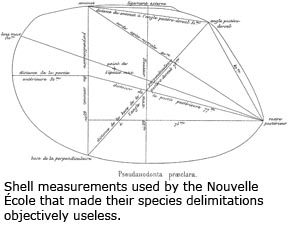 Abstract. The specimens of the French freshwater mussels (Mollusca, Bivalvia, Unionoidea) in the Arnould Locard collection in the Muséum national d'Histoire naturelle in Paris were examined. 216 type series for 308 nominal species were located, including taxa described by Locard and by other workers of the “Nouvelle École”. An annotated list of all 308 species is provided, including data regarding the relevant primary literature, type status and localities, and subsequent taxonomic opinions. Abstract. The specimens of the French freshwater mussels (Mollusca, Bivalvia, Unionoidea) in the Arnould Locard collection in the Muséum national d'Histoire naturelle in Paris were examined. 216 type series for 308 nominal species were located, including taxa described by Locard and by other workers of the “Nouvelle École”. An annotated list of all 308 species is provided, including data regarding the relevant primary literature, type status and localities, and subsequent taxonomic opinions.
Résumé. Les spécimens de moules d'eau douce de France (Mollusca, Bivalvia, Unionoidea) de la collection Arnould Locard au Muséum national d'Histoire naturelle, Paris, ont été examinés. 216 séries types pour 308 espèces nominales ont été localisées, incluant des taxons décrits par Locard et d'autres chercheurs de la « Nouvelle École ». Une liste annotée de ces 308 espèces est fournie, incluant des données concernant la littérature primaire appropriée, les statuts et les localités types, suivie d'un avis taxonomique.
Molecular phylogenetic analysis of tropical freshwater mussels (Mollusca: Bivalvia: Unionoida) resolves the position of Coelatura and supports a monophyletic Unionidae
by Nathan V. Whelan, Anthony J. Geneva & Daniel L. Graf
Published 2011, Molecular Phylogenetics and Evolution 61: 504-514. Click here for electronic access.
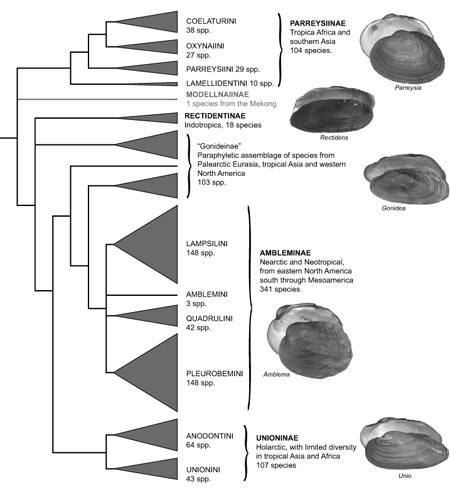 Abstract. In previous molecular phylogenetic analyses of the freshwater mussel family Unionidae (Bivalvia: Unionoida), the Afrotropical genus Coelatura had been recovered in various positions, generally indicating a paraphyletic Unionidae. However that result was typically poorly supported and in conflict with morphology-based analyses. We set out to test the phylogenetic position of Coelatura by sampling tropical lineages omitted from previous studies. Forty-one partial 28S nuclear rDNA and partial COI mtDNA sequences (1130 total aligned nucleotides) were analyzed separately and in combination under both maximum parsimony and likelihood, as well as Bayesian inference. There was significant phylogenetic incongruence between the character sets (partition homogeneity test, p < 0.01), but a novel heuristic for comparing bootstrap values among character sets analyzed separately and in combination illustrated that the observed conflict was due to homoplasy rather than separate gene histories. Phylogenetic analyses robustly supported a monophyletic Unionidae, with Coelatura recovered as part of a well-supported Africa-India clade (= Parreysiinae). The implications of this result are discussed in the context of Afrotropical freshwater mussel evolution and the classification of the family Unionidae. Abstract. In previous molecular phylogenetic analyses of the freshwater mussel family Unionidae (Bivalvia: Unionoida), the Afrotropical genus Coelatura had been recovered in various positions, generally indicating a paraphyletic Unionidae. However that result was typically poorly supported and in conflict with morphology-based analyses. We set out to test the phylogenetic position of Coelatura by sampling tropical lineages omitted from previous studies. Forty-one partial 28S nuclear rDNA and partial COI mtDNA sequences (1130 total aligned nucleotides) were analyzed separately and in combination under both maximum parsimony and likelihood, as well as Bayesian inference. There was significant phylogenetic incongruence between the character sets (partition homogeneity test, p < 0.01), but a novel heuristic for comparing bootstrap values among character sets analyzed separately and in combination illustrated that the observed conflict was due to homoplasy rather than separate gene histories. Phylogenetic analyses robustly supported a monophyletic Unionidae, with Coelatura recovered as part of a well-supported Africa-India clade (= Parreysiinae). The implications of this result are discussed in the context of Afrotropical freshwater mussel evolution and the classification of the family Unionidae.
Data Matrix. whelanetal2011.txt
Freshwater mussel (Mollusca: Bivalvia: Unionoida) richness and endemism in the ecoregions of Africa and Madagascar based on comprehensive museum sampling
By Daniel L. Graf & Kevin S. Cummings
Published 2011, Hydrobiologia 678: 17-36. Click here for electronic access.
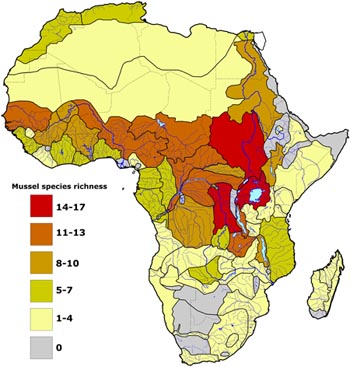 Abstract. The objective of this study was to assess freshwater mussel (Mollusca: Bivalvia: Unionoida) species distributions among the freshwater ecoregions of Africa and Madagascar to discover areas of high richness and endemism. These are among the top criteria for identifying biodiversity hotspots and establishing conservation priorities. Distributions were determined from museum specimens in 17 collections. In total, 5,612 records for 87 unionoid species could each be assigned to one of 90 freshwater ecoregions. The majority of species (55%) are known from only one (34 spp.) or two (14) ecoregions. Only three are known from more than 20 ecoregions: Etheria elliptica (38 ecoregions), Chambardia wahlbergi (25), and Mutela rostrata (21). The most species-rich ecoregions are Lake Victoria Basin (17 spp.), Upper Nile (16), Upper Congo (14), Senegal–Gambia (13), and Sudanic Congo–Oubangi (13). Those with the most endemic species are Lake Tanganyika (8 spp.), Lake Victoria Basin (6), Bangweulu–Mweru (4), and Lake Malawi (3). Twenty-five ecoregions have no known freshwater mussels. These patterns are significantly correlated with fish and general freshwater mollusk richness. Unionoid richness also varies significantly among major habitat types. These patterns are relevant to biogeography and conservation and indicate areas in need of further research. We argue that freshwater mussels are valuable as focal species for conservation assessments, and they themselves merit management consideration for their ecosystem functions and distributions in imperiled habitats. It is recommended that field surveys be conducted to determine the current status of species in all areas of Africa and Madagascar. Abstract. The objective of this study was to assess freshwater mussel (Mollusca: Bivalvia: Unionoida) species distributions among the freshwater ecoregions of Africa and Madagascar to discover areas of high richness and endemism. These are among the top criteria for identifying biodiversity hotspots and establishing conservation priorities. Distributions were determined from museum specimens in 17 collections. In total, 5,612 records for 87 unionoid species could each be assigned to one of 90 freshwater ecoregions. The majority of species (55%) are known from only one (34 spp.) or two (14) ecoregions. Only three are known from more than 20 ecoregions: Etheria elliptica (38 ecoregions), Chambardia wahlbergi (25), and Mutela rostrata (21). The most species-rich ecoregions are Lake Victoria Basin (17 spp.), Upper Nile (16), Upper Congo (14), Senegal–Gambia (13), and Sudanic Congo–Oubangi (13). Those with the most endemic species are Lake Tanganyika (8 spp.), Lake Victoria Basin (6), Bangweulu–Mweru (4), and Lake Malawi (3). Twenty-five ecoregions have no known freshwater mussels. These patterns are significantly correlated with fish and general freshwater mollusk richness. Unionoid richness also varies significantly among major habitat types. These patterns are relevant to biogeography and conservation and indicate areas in need of further research. We argue that freshwater mussels are valuable as focal species for conservation assessments, and they themselves merit management consideration for their ecosystem functions and distributions in imperiled habitats. It is recommended that field surveys be conducted to determine the current status of species in all areas of Africa and Madagascar.
The results of this study were included in the Global Freshwater Biodiversity Atlas.
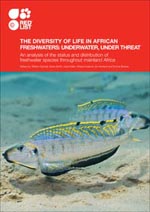 Freshwater molluscs of Africa: diversity, distribution, and conservation Freshwater molluscs of Africa: diversity, distribution, and conservation
by Mary Seddon, Chris Appleton, Dirk Van Damme & Daniel L. Graf
Published 2011, Chapter 4 in W.R.T Darwall, K.G. Smith, D.J. Allen, R.A. Holland, I.J. Harrison & E.G.E. Brooks (eds.), The Diversity of Life in African Freshwaters: Under Water, Under Threat. An Analysis of the Status and Distribution of Freshwater Species Throughout Mainland Africa. IUCN, Cambridge, UK and Gland, Switzerland. pp. 92-125. Click here for a pdf.
"Freshwater molluscs (bivalves and gastropods) are found in a wide range of freshwater habitats, have varied life-history strategies and exhibit complex ecological interactions, all of which underscore their use as proxies for understanding our changing freshwater diversity."
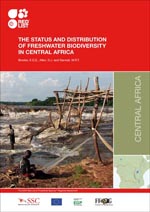 The status and distribution of freshwater molluscs (Mollusca) The status and distribution of freshwater molluscs (Mollusca)
by D.L. Graf, A. Jørgensen, D. Van Damme & T.K. Kristensen
Published 2011, Chapter 4 in E.G.E. Brooks, D.J. Allen & W.R.T. Darwall (eds.), The Status and Distribution of Freshwater Biodiversity in Central Africa. IUCN, Cambridge, UK and Gland, Switzerland. pp. 48-61. Click here for a pdf.
"The focus of this chapter is the conservation status of the freshwater molluscs of the central region of Africa. The region extends from the Sanaga to the Congo Basin (excluding Lake Tanganyika) and includes the countries of Cameroon, Equatorial Guinea, Gabon, the Central African Republic, the Republic of Congo, the Democratic Republic of Congo (DRC), Angola, and Zambia."
Evolution of asymmetrical glochidia in the Unionidae (Mollusca: Bivalvia)
by John M. Pfeiffer III & Daniel L. Graf
Presented at the 14th Molluscan Forum of the Malacological Society of London, 30 November 2011, London.
Abstract. Glochidial morphology has been an important character in freshwater mussel systematics for over 100 years. Despite its demonstrated taxonomic significance, glochidial morphology has not been considered in most modern phylogenetic studies. For example, five Southeast Asian genera have been observed to possess asymmetrical glochidia, which have a prominent marginal process on one of the two glochidial valves. Furthermore, these genera have never been strongly supported in any phylogenetic study. Although many larval characters are homoplastic, we hypothesize that this asymmetrical larval morphology represents a novel synapomorphy that is in disagreement with the current classification. Our research uses a combined evidence approach that utilizes mitochondrial (CO1 and 16S) and nuclear (28S) genes, as well as morphology to test the monophly of genera bearing asymmetrical glochidia. Tree estimation methods utilized include maximum parsimony, maximum likelihood and Bayesian inference. The results of this research will be discussed in the context of freshwater mussel larval evolution and classification. |
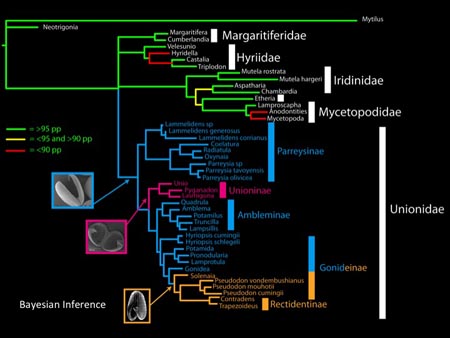 |
This slide shows the phylogenetic distributions of the various glochidium morphologies in the Unionidae. |
|
Global Freshwater Bivalve Diversity
by Daniel L. Graf
Presented at the annual meeting of the American Malacological Society as part of the James H. Lee Memorial Symposium, Mollusks: The Great Unanswered Questions, 23-27 July 2011, Pittsburgh, Pennsylvania.
Abstract. Given the ecological calamity facing fresh waters, the pressing questions facing malacologists include: How many species of freshwater bivalves are there? How are they distributed? And, what are the evolutionary processes that created these patterns? The answers are fundamental to understanding the biology of the colonization of fresh waters and for setting informed conservation priorities that can mitigate the 6th mass extinction.
Opinion varies over which bivalves should be regarded as “freshwater.” For marine biologists, mere occurrence in hypoosmotic habitats has been sufficient to merit that label. It is more informative to make a distinction between those taxa that have radiated in in-land fresh waters (i.e., < 0.5 ppt) from those that are actively (or passively) colonizing upstream from estuaries. Among extant lineages, there have been (at least) three extensive radiations in fresh water: the Unionida (six families, ca. 850 spp.), the Sphaeriidae (Venerida, > 200 spp.), and the Cyrenidae (= Corbiculidae, Venerida; ca. 100 spp.). Other typically marine/brackish families have made limited excursions above sea level, including the Mytilidae, Arcidae, Donacidae, Corbulidae, Pholadidae, and Pharidae. Most of these “peripheral” freshwater species are endemic to monsoonal Asia. In addition, two euryhaline families, Dreissenidae and Cardiidae, have radiated in the “freshened” Black and Caspian seas, but few species thrive in rivers and lakes.
My talk will focus on the three major radiations of freshwater lineages. I will discuss the results of recent phylogenetic and biogeographic investigations of the Unionida, Sphaeriidae, and Cyrenidae, with an emphasis on areas of ambiguity/controversy or where research is lacking. In general, the tropical freshwater species/clades are poorly understood and among the most imperiled. Hopefully, this review will stimulate further inquiry into global “non-marine” bivalve phylogeny and ecology. This research was funded by the National Science Foundation. |
 |
This slide shows some representatives of various freshwater and brackish-water bivalve lineages. |
|
The Illinois Natural History Survey/University of Illinois Museum of Natural History Mollusk Collection
by Kevin S. Cummings & Jeremy S. Tiemann
Presented at the annual meeting of the American Malacological Society, 23-27 July 2011, Pittsburgh, Pennsylvania.
Abstract. The University of Illinois Museum of Natural History (UIMNH) was “decommissioned” in 2005, and the Illinois Natural History Survey (INHS) obtained the orphaned UIMNH Mollusk collection on 1 May 2008. The UIMNH Mollusk Collection comprised about 45,000 lots of freshwater, terrestrial, and marine mollusks. The UIMNH Collection was assembled by Frank Collins Baker with a large portion of the collection coming from a donation by Anson A. Hinkley. The collection also includes specimens deposited by other early naturalists, including Richard Ellsworth Call, Phillip P. Carpenter, William Clench, Lorenzo E. Daniels, James H. Ferriss, Junius Henderson, Olof O. Nylander, Henry Pilsbry, John Wesley Powell, William S. Strode, Albert G. Wetherby, and James Zetek. It is a relatively old collection with specimens dating back to the mid-1800s. Over 135 countries are represented, but the collection is especially strong in freshwater mollusks in the Midwest and Southeastern United States and land snails from Southwestern U.S. and Central America. The INHS portion of the collection contains over 40,000 lots, most of which are freshwater bivalves and gastropods. In the past 25 years the INHS has been a repository of specimens from surveys conducted throughout the U.S. by state and federal agencies, non-governmental organizations, and private consultants. When combined, the INHS-UIMNH Mollusk Collection is one of the 20 largest mollusk collections in North America and contains over 320,000 catalogued specimens in over 70,000 lots, including approximately 600 lots containing type specimens. The combined collection has over 35,000 catalogued lots of freshwater mussels, approximately 15,000 lots of freshwater snails, nearly 15,000 lots of terrestrial snails, and about 5,000 lots of marine bivalves and gastropods. Over 40,000 soft parts of more than 200 species have been preserved (approximately half in ethanol) and are available for study. Information on the INHS Mollusk Collection can be found at http://www.inhs.illinois.edu/animals_plants/mollusk/. |
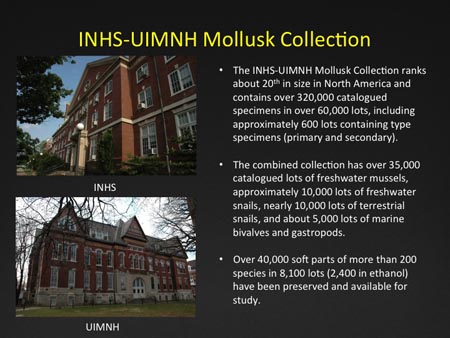 |
This slide summarizes the holdings of the INHS-UIMNH collections. |
|
Polyphyly of the freshwater mussel genus Lamprotula (Mollusca: Bivalvia: Unionidae)
by John M. Pfeiffer III & Daniel L. Graf
Poster presented at the annual meeting of the American Malacological Society, 23-27 July 2011, Pittsburgh, Pennsylvania. Winner of the best student poster award!
Updated versions of this poster were presented at the Young Systematists' Forum, 1 December 2011, London and the International Meeting on Biology and Conservation of Freshwater Bivalves, 4-7 September 2012, Bragança, Portugal.
Abstract. The freshwater systems of Asia are among the most imperiled in the world, but conservation efforts in the region are hindered by (among other biological and sociopolitical challenges) our inability to answer basic questions about biodiversity, including the family Unionidae. Despite more than a decade of molecular phylogenetic studies on freshwater mussels, taxonomic sampling from tropical lineages has been too sparse to resolve the relationships of tropical Asian species. It is imperative that these hypotheses of relationship be tested in order to provide phylogenetic information crucial to natural resource management.
Preliminary phylogenetic analyses of mitochondrial DNA (ND1 and 16S) recovered the Asian freshwater mussel genus Lamprotula as polyphyletic (Zhou et al., 2007 Cur. Zool. 53(6): 1024-1030). However, the taxon sampling for the two data partitions were incongruent and the methods of analysis were incomplete to derive convincing conclusions. We set out to augment this published dataset by combining the two partitions into a single matrix and provide more complete ingroup and outgroup sampling by utilizing novel and published sequences. This concatenated and broader taxonomic dataset was used to test the validity of the polyphyletic nature of Lamprotula and associated family-group level relationships. Tree estimation was completed using Bayesian Inference (2 runs of 8 chains, 18 X 106 MCMC generations, retaining every 1000th tree, and omitting the first 6000 as burn-in) and Maximum Likelihood (RAxML: 2000 bootstrap replications).
This reanalysis confirms that Lamprotula is polyphyletic, recovering species in two distinct subfamily clades. This reconstruction resolves many family-group level relationships that are not present or inconsistent with the initial analysis, including strong support for the monophly of the unionid subfamilies and the presence of a plesiomorphic unhooked larval condition. The results of these analyses of molecular phylogenetics are discussed in the context of freshwater mussel taxonomy and evolution. |
|
Patterns of freshwater mussel richness and endemism in Africa and Madagascar
by Daniel L. Graf & Kevin S. Cummings
Presented to the Freshwater Mollusk Conservation Society, 11-15 April 2011, Louisville, Kentucky.
Abstract. Patterns of richness and endemism are among the top species-based criteria for identifying biodiversity hotspots. In order to assess these patterns among freshwater mussel species at the scale of the 90 freshwater ecoregions of Africa and Madagascar (and associated islands), we sampled specimen records from 17 major research collections on three continents. Of 6632 museum lots representing 87 species in four families, 5612 had locality data precise enough to assign them to an ecoregion. More the half of freshwater mussel species occurred in two or fewer ecoregions (48 spp.). At the opposite end of the spectrum, only three species occurred in greater than 20 ecoregions: Etheria elliptica, Chambardia wahlbergi and Mutela rostrata. Twenty-five ecoregions had no mussel records, and the two most species-rich ecoregions were the adjacent Upper Nile and Lake Victoria Basin (16 and 17 spp., respectively). The region-wide patterns of freshwater mussel richness and endemism are significantly correlated with both fish and general freshwater mollusk distributions. The relevance to these analyses to freshwater mussel conservation in Africa will be discussed. |
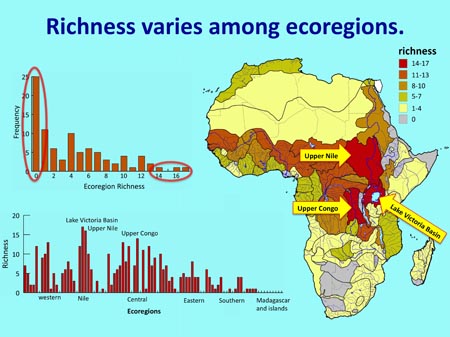 |
This slide shows the patterns of freshwater mussel species richness among the ecoregions of Africa and Madagascar. |
|
Polyphyly of the freshwater mussel genus Lamprotula (Mollusca: Bivalvia: Unionidae)
by John M. Pfeiifer & Daniel L. Graf
Presented to the Southeastern Ecology and Evolution Conference, 25-27 March 2011, Auburn University, Auburn, Alabama. A poster of this research subsequently presented at the 2nd Annual Frontiers in Biology Research Colloquium, 20 April 2011, University of Alabama, Tuscaloosa.
Abstract. The freshwater systems of Asia are among the most imperiled waterways in the
world (Dudgeon 1992, Dudgeon 2000), but conservation efforts in the region are
hindered by (among other biological and sociopolitical challenges) our inability to
answer basic questions about biodiversity and constituent aquatic taxa, including
freshwater mussels of the family Unionidae. For example, how many lineages
are present and what are their relationships to taxa in other regions. Despite
more than a decade of molecular phylogenetic studies on freshwater mussels,
taxonomic sampling from tropical lineages has been too sparse to resolve the
relationships of the 217 tropical Asian species (Graf & Cummings, 2007). The
taxonomic classification of this global freshwater mollusk hotspot predates
modern cladistic methods, and is imperative that these hypotheses of
relationship be tested in order to provide phylogenetic information crucial to
conservation biologists and resource managers. Preliminary phylogenetic
analyses of mitochondrial DNA (ND1 and 16S) of Chinese freshwater mussels
recovered the genus Lamprotula as polyphyletic (Zhou et al., 2007). However,
the taxon sampling for the two data partitions were incongruent and the methods
of analysis were incomplete to derive convincing conclusions. We set out to
augment this published dataset by combining the two partitions into a single
matrix and providing more complete ingroup and outgroup taxon sampling.
Our reanalysis confirms that Lamprotula is polyphyletic, recovering species from
two distinct subfamily clades. The results of our analyses of molecular
phylogenetics and generic nomenclature are discussed in the context of
freshwater mussel taxonomy and evolution. |
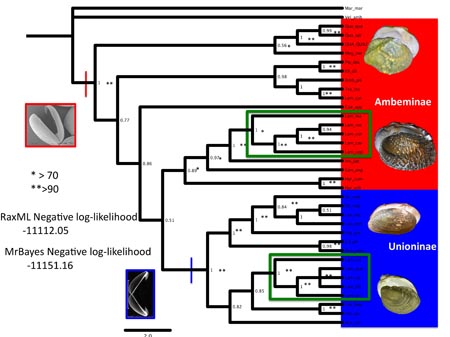 |
This slide depicts the 50% majority rule consensus topology derived from Bayesian Inference, which was identical in topology to the optimal tree from RAxML. Lamprotula (green boxes) was recovered as polyphyletic. |
Click here to view (or download) an enlarged jpeg of the poster.
|
|